Category — Research Themed Sessions
An Open-Access, Standards-Supportive Publication that Rapidly Disseminates Concise Genome and Metagenome Reports in Compliance with MIGS/MIMS Standards: the Session Blog
Presenters: Oranmiyan W. Nelson
July 9, 2009 at 2:30 pm
Background
Dr. Nelson is currently completing his post-doctoral work at Michigan State University, in the Department of Microbiology & Molecular Genetics. He is also the production editor of Standards in Genomic Sciences (SIGS), an open-access e-journal of the Genomics Standards Consortium (GCS) established in September 2005.
Session Overview
Genomics and metagenomics describes the study of an organism’s complete genetic data set, with emphasis on sequence mapping. The former is limited to the study of organisms that can be isolated in pure culture, whereas the latter applies to an entire community of microbes in their native environment. Technological advancements have facilitated a data explosion; genomic maps are now being produced at a faster rate than the existing publication infrastructure can accommodate. The result is a loss of data, contextual metadata and annotation. Essentially valuable data is disappearing before it can be interpreted or see the light of publication.

Number of published journal articles per year relating to the complete genome sequences of bacteria and archea
SIGS is a GSC initiative to attempt to bridge this gap, by producing concise peer-reviewed reports that comply with MIGS/MIMS standards, in addition to operation procedures, commentary and review articles. Minimum Information about a (Meta)Genome Sequence (MIGS/MIMS) is a GCS initiative to expand on core reporting standards already established by the International Nucleotide Sequence Database Collaboration (INSDC). MIGS/MIMS is characterized by a standardized checklist that has been published in its entirety in Nature Biotechnology. SIGS will attempt to keep up with data production by offering an accelerated editorial revision workflow, where copy-editing begins almost immediately after initial acceptance.
The e-journal’s goal is to produce 600 publications by June 2011 (approximately 30 per month), by attracting internationally credible authors under a cost-effective model for an open-access journal.
A sample short genomic report was then described, in conjuction with MIGS/MIMS standards. The anatomy of a report included a abstract and introduction (a), genetic sequencing information (b) genome properties (c) and comparisons with previously sequenced genomes (d). Lastly, conclusions and references (e).
References
July 13, 2009 Comments Off on An Open-Access, Standards-Supportive Publication that Rapidly Disseminates Concise Genome and Metagenome Reports in Compliance with MIGS/MIMS Standards: the Session Blog
Synthesis: Africa-related Sessions at PKP 2009
“There is no way we can succeed in the eradication of poverty if the developing world is not part of the knowledge creation, its dissemination and utilization to promote innovation. Higher education is a critical factor in making this possible and must be part of any development strategy.” – Mamphela Ramphele
(as cited in the AJOL presentation – July 9, 2009)
Introduction
The conference included a healthy representation of Africa-focused initiatives that were profiled in the following workshop sessions:
1. Establishing a new open access journal in Africa: the case study of the African Journal of Primary Health Care & Family Medicine (PHCFM) – Pierre de Villiers (blogged by Tracy Scott)
2. Knowledge production through scholarly publishing in sub-Saharan Africa: a bibliometric analysis of the period 1996-2007 – Ezra Ondari-Okemwa (blogged by Jeffrey D.)
3. Online publishing education in Africa: a new program at KNUST – Lucy Ry-Kottoh, Eric Anane-Antwi, Samuel Smith-Esseh CANCELLED
4. Open Journal Systems (OJS) software as used by African Journals OnLine (AJOL) – Susan Murray (blogged by Pam Gill)
5. Scholarly publishing in Africa: the online potential, the online challenge – Samuel Smith-Esseh (blogged by Lauryn Oates)
In addition, several other sessions addressed open access issues in the developing world (or ‘global South’) more generally. The following synopsis is based on sessions #1,4 and 5.
Common Themes
– Developed world scholarly journals are simply out of reach, in an economic sense, to the vast majority of academics and professionals in Africa;
– The growth in interest, availability of data, partnerships and new OSS is growing exponentially, with new African institutions and partners steadily coming on board;
– There is increased interest in African scholarship from the outside world, related to the new lines of access emerging: helping to instigate a two-way information flow. This has huge potential to change the dynamics of the information society and is about voice, representation, participation and leaving a unique cultural imprint;
– Common values in sustainability emphasis and quality of information and presentation; not all viability issues are solved- further innovation is needed here- though ‘Family Medicine & Primary Healthcare’s’ experience show the viability of using an OA approach as a business model;
– Relevancy of Creative Commons licenses to these new initiatives;
– Multinational partnerships are often utilized to launch OA initiatives for developing world: international funding sources are leveraged with international expertise, local partners- truly networked;
– Production costs for on-line publications are significantly lower than print;
– Language accessibility is increasingly on the radar but no initiatives profiled were in indigenous African languages;
– The sessions had a focus on software and information, with less emphasis on hardware, connection and physical accessibility challenges, for which there was little overall discussion;
– Support to authors, African publishers and institutions will be critical for increasing local production.
Looking Ahead
In future PKP conferences, it will be valuable to continue following developments with the Africa initiatives, addressing emerging trends, challenges and opportunities. However, it will also be useful to draw in participants affiliated with other regions of the developing world. Specifically, considering access to scholarly journals in countries where internet access is restricted and the information environment is characterized by an authoritarian political environment could yield more sensitivity to the special challenges faced in such contexts and spur innovation that might address such challenges.
Some concluding notes from the AJOL session sum up well critical lessons learned and set forth some principles for future work:
1. “Technological tools are just the vehicle”: relationships and communication are still the drivers of success.
2. Choose partners wisely and work closely with them.
3. Listen to the needs of your users and beneficiaries.
4. OSS has matured.
5. And for Africa- get a critical mass of African-published work on line.
Resources for Further Study
Aluka – Building a digital library of scholarly resources from and about Africa
Council for the Development of Social Science Research in Africa

(source)
July 13, 2009 1 Comment
Publishing Freedom of Information: the Open Government Records Plug-In for OJS: The Session Blog
Presenter: Mark Weiler, PhD Candidate, Simon Fraser University
Background
Freedom of information (FOI) legislation was enacted in Canada in 1983. This legislation, in existence in various forms throughout the world, allows individuals to request access to government-held information. In Canada, there is no formal database to allow interested parties to search for previously submitted FOI requests, or for the documents released as a result of these requests.
Session Overview – Session Abstract
Mark Weiler is interested in developing technologies that allow students and other academics to carry out historical research. Recently, he became interested in the use of Open Journal Systems (OJS) and its capacity to make government-held knowledge more accessible to academics as well as to the general public. This interest is in keeping with the aims and goals of the Open Access movement, namely, to make accessible information held by the government through Freedom of Information legislation.
Open Government Records (OGR), initially designed as a plug-in for OJS, helps journals to submit, track and publish FOI requests and the resulting correspondence and documentation that follows these initial requests.
The OGR website currently offers access to several FOI repositories touching on a number of areas of interest, including public servant curriculum and scholarships/grants. What the website allows, above and beyond what a traditional print-published compilation of the FOI requests would, is the ability to offer access as the documents are obtained.
Commentary and Questions
The ensuing discussion highlighted a number of the potential uses of the OGR technology. Notably, journalism schools were felt to be likely beneficiaries. This type of repository could help inform work on government policy, public servant salaries, etc… There was concern, however, that journalists may be reluctant to submit FOI requests to a database for fear of being “scooped”.
Another area of discussion concerned to potential use of this type of technology to help users submit information requests to journals in order to obtain more information about their corporate structure and partnerships.
Related links
Below are a series of links to websites and societies dedicated to civic action and freedom of information;
Open Government Records – The OGR website, with its FOI repositories.
Visible Government – A Canadian NGO website dedicated to increasing government transparency.
What Do They Know? – Database of UK FOI requests.
MySociety – UK civic action website.
References
Weiler, M. (2009). Publishing freedom of information: the open government records plugin for ojs. PKP Scholarly Publishing Conference 2009. Retrieved 2009-07-08, from http://pkp.sfu.ca/ocs/pkp/index.php/pkp2009/pkp2009/paper/view/131
July 12, 2009 Comments Off on Publishing Freedom of Information: the Open Government Records Plug-In for OJS: The Session Blog
Who knows what, when? Current and desired capacities for online journal statistics gathering and dissemination: The Session Blog
Friday, July 10, 2009 @ 9:30
SFU Harbour Centre (Earl & Jennie Lohn Rm 7000)
Presenters:
Andrea Kosavic (Digital Initiatives Librarian at York University)
James MacGregor (PKP Associate)
Session Overview
James MacGregor and Andrea Kosavic outline their efforts to provide a suitable recommendation to Synergies Canada on what they should provide in terms of statistics and to whom based on a survey of current and desired practices in online journals. Kosavic explained that her interest in participating in this study stemmed from having multiple statistics requests at once at York and being overwhelmed by the lack of a streamlined method of reporting this information.
Commentary
In trying to establish a recommendation to Synergies Canada regarding what statistics should be collected and shared, Kosavic and MacGregor proceeded to:
1) establish what is currently supported or lacking.
2) survey journals and repository holders to see what they actually need.
3) draw up recommendations.
Using Open Journal Systems (“OJS”) and Erudit Consortium as targets for recommendations, the following was initially noted:
– they do not share common statistics collection;
– both can capture the number of items viewed per month (with the help of external software);
– other statistics are difficult to capture; and
– both have reporting functionalities.
Key questions were asked of respondents in order to frame findings with 75% of respondents claimed that their current statistics collecting solution was not satisfactory.
Key findings include:
– 51% of OJS users utilize the built in reporting tool.
– 30% of respondents use 2 or more tools.
– Identifiying the number of “unique visitors” was deemed the most important statistic.
– Web pages accessed and page clicks were identified as the most collected statistics.
– RSS feed information was identified as the least collected statistic.
– Statistic collection ranged from monthly to quarterly to yearly with no significant majority.
In regards to the sharing of statistical information, the survey indicates that a significant gap exists between who journals are currently sharing statistics with and who they anticipate sharing statistics with.
Kosavic and MacGregor learned that there appeared to be no ideal statistical management system. The speakers were asked by someone in the audience about whether or not it will be possible to tell whether or not an end user is actually reading an article and if so, how much and what is being cited (if anything). MacGregor explained that this statistic was not collected and that there is currently no way to track this information; another member of the audience compared it to trying to be able to track how much of a book a library patron read. Ultimately this would be ideal to be able to track but unrealistic in the near future. It was also noted that referrer statistics were not included in the survey, that is, information related to how viewers came to find a journal site/article.
Recommendations for statistical gathering and disseminating:
– should standardize on 3rd party reporting across all nodes;
– use SUSHI protocol to collect statistics;
– implement COUNTER protocol to collect statistics;
– extend COUNTER to cover other Synergies items.
At different points in the presentation, MacGregor showed a different visual representation based on his gradually refining understanding of current and desired capabilities and the flow of statistical dissemination. This was helpful in demonstrating that initially there were many complicated methods of statistic collection and possibilities but eventually, with greater understanding, MacGregor was able to illustrate an easy to understanding model for statistic management.
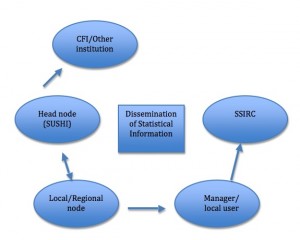
(Figure 1.0 – Final visual representation representing a steamlined view of the dissemination of statistical information)
Stakeholders, statistics desired and relevant protocols have been identified and the final report is in the process of being completed.
Related Links
July 10, 2009 Comments Off on Who knows what, when? Current and desired capacities for online journal statistics gathering and dissemination: The Session Blog
Do Not Press Print: What Can We Do to Keep the Reader Engaged in Online Use of Journals?: The Session Blog
When: Friday, July 10, 2009 3:30pm – 4:30pm
Room: Main Concourse – Fletcher Challenge Room 1900
Presenters: Rick Kopak, Chia-Ning Chiang
Rick Kopak is an Assistant Professor at the School of Library, Archival, and Information Studies, UBC. Chia-Ning Chiang is a PhD Candidate at the School of Library, Archival, and Information Studies, UBC.

Chia-Ning Chiang and Rick Kopak (Source: Photo taken by Helen Szeto)
Session Overview:
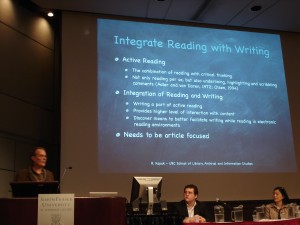
Rick Kopak presentation (Source: Photo taken by Helen Szeto)
The purpose behind this session is to look at ways to engage journal readers through the journal’s interface. Rick Kopak and Chia-Ning Chiang presented a series of reading tools in the Open Journal System (OJS) that will critically engage readers as they read through the articles. They want to provide an environment that enables an active reading process where they are thinking about the information as they read.
The reading tools will help the reader focus on the article and interact with it. Also, the reader can bring in other related information on the topic; making connections in the process. Kopak gives examples of reading tools found in other models: highwire press, PubMed and PIRA (Personal Information Retrieval Assistant).
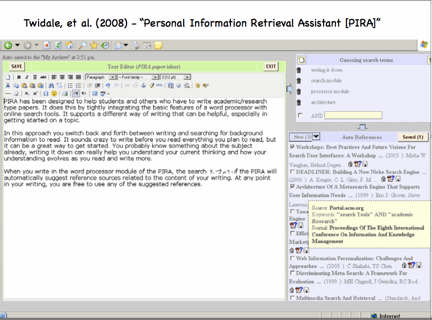
PIRA screen capture (Source: slide courtesy of Rick Kopak)
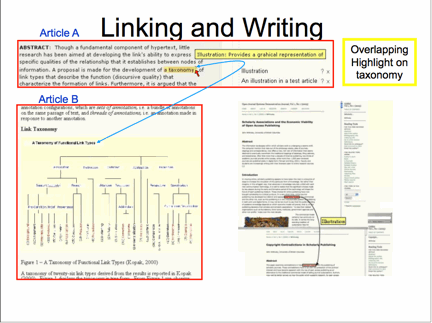
Linking and Writing (Source: slide courtesy of Rick Kopak)
For the prototype of reading tools being developed for OJS, there are two components: annotation and linking. Writing annotations allow the reader to capture their thinking process as they read. They also provide a visual search of ideas on the sides of the article. In the prototype, readers can highlight text and space is allotted on the side for notes. Linking and link typing are extensions of annotation. Readers can link to another piece that elaborates on the article topic. The idea behind linking is to capture relationships between different journals and make connections.
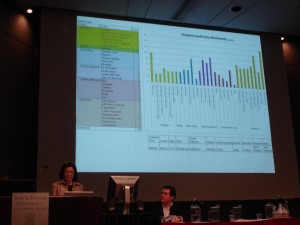
Chin-Ning Chiang Presentation (Source: Photo taken by Helen Szeto)
During Chin-Ning’s part of the presentation, she reviews a bar graph chart that compares the features of reading tools from 2006 to 2009. There are social components to article reading as well. Reader comments can be found at the bottom of the page. Chiang argues that comments at the bottom of the page are ineffective because people rarely scroll down to the bottom. Also, readers lose context when they scroll away from the text.

reading tools chart (Source: slide courtesy of Rick Kopak)
There are 5 parts that Chiang and Kopak would like to include in their production version of OJS reading tools: highlighting, note making, workspace, public views, and linking. Chiang and Kopak would like the reader to have more control over highlighting, including the choice of colours and tone densities. For note making, readers would be able to toggle the note function on and off, and have the ability to fold long notes. A workspace will also be created for people to start composing and clipping notes and text to the workspace. In the public view mode, individual markings can be shared which promotes social interaction among academics. It allows readers to view the multiple commentaries in an article. Finally, the linking function will give the user more control. Some of these abilities include clicking links off and on, creating hyper links and being able to tag annotations and highlighted text.
(Source: powerpoint presentation courtesy of Rick Kopak)
Session Analysis:
Chiang and Kopak were clear on their intentions on creating reading tools for OJS. They referred to existing reading tools to show improvements they wanted to make. The screenshots of the various interfaces were helpful visuals to understand the different tool functions. The rationale behind each component and their beneficial functions were clearly explained to persuade the audience that the reading tools will enrich the reading process greatly in OJS.
Session Questions and Answers:
A gentleman in the audience posed the following questions: What about the editorial view? Can we apply these tools there?
I couldn’t hear the reply clearly, but Kopak sent me an email reply to the questions asked.
Kopak’s reply: “The gentleman’s question concerned whether we ever thought of using the Annotation and Linking Reading Tools for the Editorial view in OJS in addition to the Reader View. I said yes, we had considered it, and it might be a feature in the Editorial View at some point in the future. But, at the moment, we were focusing on the readers of OJS journal articles. In the Editorial View, editors and reviewers could comment on journal articles directly using the Annotation Tool specifically, and editors could give editorial instructions as well.”
Related Links:
- School of Library, Archival and Information Studies, Univers
- PKP 2007 – A Multi-dimensional Approach to the Study of Online Annotation (presented by Rick Kopak & Chia-Ning Chiang)
- OJS Help – Reading Tools
July 10, 2009 Comments Off on Do Not Press Print: What Can We Do to Keep the Reader Engaged in Online Use of Journals?: The Session Blog
Knowledge production through scholarly publishing in sub-Saharan Africa: a bibliometric analysis of the period 1996-2007
Presenter
Ezra Ondari-Okemwa, Senior Lecturer and Head, Department of Library and Information Sciences, University of Fort Hare, South Africa.
Session Overview
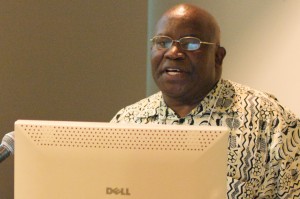
Photo: J. Miller - PKP Conference
Dr. Ondari-Okemwa introduced his talk by explaining that his research specifically focused upon the sub-Saharan region of Africa during its most productive period in terms of knowledge production, 1996-2007. The level of scholarly publication in sub-Saharan Africa is of critical importance, as this activity enables scholars to share what they know with their peers within the region. Such activity, researchers in sub-Saharan Africa can create new knowledge rather than only relying on scholarly research that emanates from the developed world.
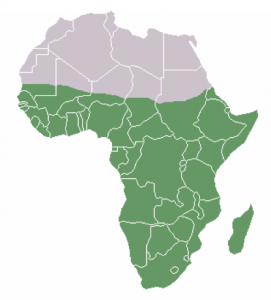
A map showing the boundaries of sub-Saharan Africa – South of the Sahara Desert
Ondari-Okemwa’s called into question the accuracy of indicators of scholarly publication from sources such as Thomson Reuters as its data focuses predominantly upon publications from North America, Europe as well as publications in the English language. He also identified that knowledge production was not uniform and took at least two dominant modes, only one of which benefited from the funding sources typically available to African researchers. The first mode of knowledge production is a linear one, one that is almost exclusively academic, investigator focused and discipline based. This mode of knowledge production leans heavily on scholarly publication. The second mode, one that started to emerge in the mid-twentieth century is far more context and problem-focused, with an interdisciplinary and reflexive orientation. This mode leans more towards the types of knowledge production we see in emerging interdisciplinary academic disciplines such as Developmental Studies, Knowledge Management and Gender Studies. This latter mode, seems particularly under-represented in the data on sub-Saharan African scholarly production, in part because funding sources are less likely to be found for such research in the social sciences than, in say, Medicine or Science. As such, the majority of the scholarly publications that were published during the time-period of the study (1996-2007) show a strong emphasis on science-based disciplines. Other disciplines were not widely represented.
Ondari-Okemwa also spoke to the potential benefits of Open Access and electronic journals in the context of scholarly activities in sub-Saharan Africa, specifically, and in Africa in general. Without question, the availability of such resources has had a positive impact on the research connections between the leading institutions. Such resources can be readily and exhaustively searched, readers can quickly move from citations to the cited works themselves with a single click, and the full range of bibliographic references are easily available and retrievable. However, a general state of technological deprivation in sub-Saharan Africa excludes most scholars from contributing to knowledge production in the region.
Ondari-Okemwa identified several key hurdles to scholarly publishing and knowledge production in Sub-Saharan Africa:
- There is little or no use of locally produced knowledge
- Invisibility of scholarly publications emanating from sub-Saharan Africa
- Technological hurdles such as poor Internet connectivity and low teledensity
According to Ondari-Okemwa, governments in sub-Saharan Africa need to address issues such as low and eroding salaries, social unrest and political conflicts including war, to address the reasons why so many people leave the region. In concluding, Ondari-Okemwa acknowledged the many strategic challenges facing most institutions of research and learning in sub-Saharan Africa, but felt strongly that steps needed to be taken to ensure higher rates of production of knowledge. These local scholars must play a role in this as they are best-placed to produce such knowledge about the region.
Question period
During the question period, several issues raised by the audience focused upon infrastructure challenges within African universities and the pressure upon scholars within those institutions to conduct their research in areas of interest to the developed world. Many in the room made reference back to the hurdles to scholarly publishing earlier mentioned by Ondari-Okemwa and to the fact that connectivity is a critically important factor that is limiting the possibilities for universities throughout Africa to engage more fully in research activities. With respect to funding for research, one audience member questioned whether or not the World Bank model of development really calls for the production of new knowledge from African countries. More often, it seems to narrowly task universities to reproduce existing research and to focus instead on increasing numbers of graduates in areas that align with its definitions of economic growth in the region. Ondari-Okemwa acknowledged that universities were increasingly being asked by government to shift to the mass production of graduates. The universities are caught up in a struggle with increasing enrolments without a concomitant increase in funding sources, and this results in fewer opportunities for scholars to focus on research activities.
Another issue that came up during the question period concerned the invisibility of many African scholarly journals. There are hundreds of journals that are not online and not visible being hidden within institutions and only available to a limited number of scholars and readers. Ondari-Okemwa responded by saying that it will be difficult to change this situation, though initiatives like African Journals Online is helping to make African journals more visible.
Related Links
Ondari–Okemwa, E. (2007). “Scholarly publishing in sub–Saharan Africa in the twenty–first century: Challenges and opportunities.”
First Monday, Volume 12 Number 10 – 1 October 2007
Ondari-Okemwa, E. (2004). Impediments to promoting access to global knowledge in sub-Saharan Africa. Library Management, 25(8/9):361-375.
Ondari-Okemwa, E. (2002). Challenges of harnessing virtual information resources: the case of the African Virtual University. Journal of Information Science 28(4): 321–329.
July 10, 2009 Comments Off on Knowledge production through scholarly publishing in sub-Saharan Africa: a bibliometric analysis of the period 1996-2007
Understanding Impacts and Implementations of New Knowledge Environments: The Session Blog

Dr. Ray Siemens presents at PKP 2009. Photo by C. Gratham
Presenter: Dr. Ray Siemens, Director, Implementing New Knowledge Environments (INKE) Project. Canada Research Chair in Humanities Computing and Professor of English, University of Victoria. Bio
July 10, 2009, 2:30 pm-3:00 pm. SFU Harbour Centre. Rm 1900
Background
The INKE project represents the interdisciplinary work of researchers with specialties spanning humanities, text analysis, information studies, usability, and interface design. The team consists of 35 researchers, 20 institutions, and 20 other partners. Their SSHRC funded work takes a scholarly approach and cast an eye back on the history of the print medium to help understand the roles digital books might play in the future.
Session Overview
After providing an over-view of the team and project, Dr. Siemens summarized the motivation for the study by stating that e-books and e-textuality have “an exciting future … but an inconvenient present”. The exciting future can be illustrated by how pervasive various digital forms of text have already become in society today. But the inconvenient present lies in how little we actually know about this new media form and how the gaps we need to fill before we can make decisions about how to best use this “new knowledge machine”.
We still have a long way to go. As Dr. Siemens reminds us, “the e-book is still just a pale representation of it’s paper counterpart.” He suggests that one of the main reasons for this is that we still model electronic documents to mimic their print based forms and in doing so we import the same conceptual models from the print world. To achieve the benefits of e-books and documents, Dr. Siemens says that we need to reconceptualize these core critical and textual models.
The team’s research is clustered around the following four interdisciplinary areas: textual studies, user experience, interface design, and information management. And through these clusters they have identified a number of gaps in the existing knowledge leading to the following research questions:
- Has the way we read and experience information changed since the rise of the Internet, and, if so, how?
- How do different knowledge environments influence the way we engage and use information?
- What new features can we design to improve digital information environments and their interfaces?
- How can we better design the data that underlies and serves the needs of those using such digital information environments?
- How does this interdisciplinary team work together to achieve our research objectives given the multiple lenses through which they approach the same questions?
Dr. Siemens closed his presentation with three “Rubber hits the road” impact questions:
- Can the humanities find this problem worth engaging with?
- Can the interdisciplinary cores yield something tangible?
- If so, will the results be socially applicable, embraceable, and ubiquitous?
Questions
Time limitations did not allow questions for Dr. Siemens
Related Links and References
July 10, 2009 Comments Off on Understanding Impacts and Implementations of New Knowledge Environments: The Session Blog
Critical Mass is Critical – Creating Sustainable Scholarly Communication: The Session Blog
When: Friday, July 10, 2009 2pm – 3pm
Room: Main Concourse – Fletcher Challenge Room 1900
Presenter: Gregg Gordon
Gregg Gordon is President and CEO of the Social Science Research Network (SSRN). SSRN is a digital repository that has close to 100,000 full-text documents. The network allows readers access to full text and articles without any changes, but no access to the meta data attached to the articles. It has received approximately 30 million downloads so far. SSRN is part of the social networking community through a blog, Facebook, and Twitter.
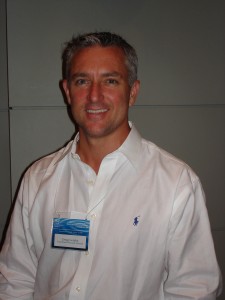
Gregg Gordon (Source: Photo taken by Helen Szeto)
Session Overview:
Gordon’s presentation is about the growing amount of scholarly information that is out there and the connections that can be made with it. He starts off by defining the term “critical mass.” Critical mass is the minimum amount of something required to start or maintain a venture. Gordon believes that there is an endless abundance of information out there. There is a lot of research, but he asks the question, how can academics sort through everything? The biggest complaint received at the SSRN is that there is too much information with over 1000 journals available on the network.

(Source: slide courtesy of Gregg Gordon)
Gordon explains how the scholarship of information is growing. The Open Journal System (OJS) has enabled the creation of over 3000 OJS journals, which means over 3000 new publishers. Every 20 years, the amount of scholarly journals available is doubled. Ninety percent of all scientists are alive today, which means they are still making contributions to the scholarly world. The amount of research available increases because readers are getting access to earlier research stages. In the SSRN, 13% of the citations are towards working papers. Drafts are being referenced. Interdisciplinary classifications are also increasing research relevance. Academics are able to see the content from a broader amount of subjects.

(Source: slide courtesy of Gregg Gordon)

Gregg Gordon Presentation (Source: Photo taken by Helen Szeto)
Gordon says that traditional publishing models are slowing innovation. On the other hand, clusters of information are increasing innovation. Information is being connected to make more meaningful relationships. People are growing up with access to information and therefore understand that information needs to be free. Depositories are being built, but not used widely. Greg offers a formula to get people to the depositories. “C(onversation) + C(onnections) = C(ommunity)” Communities will form when people are talking about the information out there and making connections with the pieces. Gordon says as you find more content, you determine what is important to you. The community also has to provide many means to access the information. Content is being accessed through the web and various social networking sites. Wireless allows information to be accessible anywhere and everywhere.

Clusters and Connections of Relevant Information (Source: slide courtesy of Gregg Gordon)
In Gordon’s search trend analysis, he has discovered that people are looking at blogs and wikis to find what is important to them. Journal use has declined a little bit in trend. Gordon makes a reference to a NY Times article regarding Google search being replaced by YouTube in an elementary school.
The overall underlying message is that communities are key to sharing ideas and making relevant connections in your field of study.
Session Analysis:
Gordon makes good use of visual slides to display his ideas of growing information and the communities that emerge from the connections being made. By visually being able to see the clusters of information and the connections they form, we have a better understanding of their impact. Gordon has shown that repositories will be more efficiently used when the information is clustered and networks are created. We learn that communication is vital in grouping relevant research together. People need to have discussions and to share their ideas in the communities. Gordon is showing us how we can make better use of the information mass that is already out there.
Session Questions and Answers:
1) Why is there more structure in the scholarly publishing of hard sciences than in the social sciences?
Reply: Gordon compares scientific, technical and medical (STM) publishing and social sciences to a rifle shot and a shotgun approach. STM is like a rifle shot where information is very cloistered. “Social sciences have a shotgun approach because you want to get your information out there by getting published. In the hard sciences, you are writing to fund your lab, while in the social sciences; you are writing to build your lab.” There are two clear differences in submission approaches. “Some academics do not want to submit anything until it is it ready, while others will send out a proposal to put their stake out there.”
2) Gordon also comments that there needs to be a person checking the data to ensure that quality is there.
Related Links
- Social Science Research Network (SSRN)
- PKP 2007 – Creating Scholarly Communities and Fostering Innovation (presentation by Gregg Gordon)
- Critical Mass is Critical, Building Authority in a Changing World (under Feb 6, 2009 – video of G. Gordon’s presentation)
- Bepress: The Other Legal Repository
- An Interview with SSRN’s Gregg Gordon
July 10, 2009 Comments Off on Critical Mass is Critical – Creating Sustainable Scholarly Communication: The Session Blog
The OJS Community: who is doing what with OJS: The Session Blog
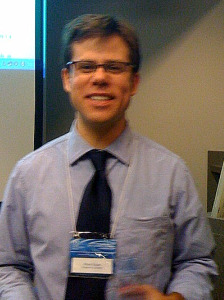
Brian Edgar at PKP 2009. Photo by C. Gratham
Presenter: Brian Edgar – Stanford University. Bio
July 10, 2009, 10:00-am-10:30 pm. SFU Harbour Centre. Rm 7000
Session Overview
Mr. Edgar presented the preliminary results from a survey of over 1,000 OJS editors around the world. The goals behind the survey were to gather information about who is using the journals, where they are located, and to gain a sense of their funding models as well as what motivates them to do this work,
While the data analysis is still in the preliminary stages, Mr. Edgar presented some of the survey results and commented on a number of the findings as follows:
- South America, Europe, and North America (in descending order) accounted for 75% of the journals
- Almost half the journals were in the Social Sciences with Health Sciences and Technology and Engineering the next most common topic areas
- More than half the journals were sponsored by academic departments and another third by scholarly associations
- The rate at which the journal accepted articles was quite variable with roughly equal numbers distributed across all the acceptance rate bands
- A very high percentage of the journals used editorial and double blind review procedures
- In most of the journals, the editor is personally responsible for copy editing, layout, and proofreading
- But it is not a full-time job for the editors. In 80% of the journals, editing requires less than ten hours per week.
- Most of the journals reported small (or zero) expenses and revenues. However, a small percentage reported more than $50,000 in both. Mr. Edgar commented that these zero expense journals seem to indicate a new model for journal publishing becoming possible
- For those journals that generated revenue, it mostly came from institutional funding, followed by subscriptions, and then from advertising
- Most of the editors were motivated to do their work due to a desire to provide new knowledge and a service to the community and not for financial benefit
- While 83% of the journals qualified for inclusion in the Directory of Open Access Journals (DOAJ), only 22% actually were included
- Around 40% of responders continued to produce print journals
Questions and Audience Comments
A lively discussion ensued following Mr. Edgar’s presentation. Some of the key points are as follows:
- While the data analysis is still preliminary, they hope to have a more complete analysis by the fall of 2009.
- One audience member asked how many of the OJS journals were included in the ISI. The original survey didn’t ask about inclusion in the ISI, but they did ask about indexing.
- There was considerable discussion about why the number of OJS journals in DOAJ is small. One possible explanation is that the DOAJ has a big backlog in evaluating journals for inclusion, so it may be possible that the number of OJS journals in DOAJ will be increase as the backlog is cleared.
- There was also much discussion about those institutions reporting zero costs. There are real costs: servers, people’s time, cost of producing the knowledge, etc. But some felt that those costs are rightly viewed as a part of the operating costs of the university and it may be legitimate to not include them specifically in the journal cost. On the other hand, some people need to be able to put a time/cost as part of their justification to create an OJS journal, and they would like to see those costs broken out. An audience member pointed out that the data collected (e.g. hours per week that editors spend on the journal) can be converted to generate this data.
Related Links
July 10, 2009 2 Comments
Towards A New Future for Journal-Article Publishing: The Session Blog
When: Friday, July 10, 2009
Room: Main Concourse – Fletcher Challenge Room 1900
Time: 9:30 am – 10:30 am
Presenter: Frederick “Fred” Friend
Fred Friend studied history in Kings College, London. Next, he obtained a post graduate library qualification at the University College in London. Fred’s library career has spanned from Manchester University, to the University of Leeds, to the University of Nottingham and finally at University College in London. He currently holds the title of Honorary Director of Scholarly Communication at the University College in London. He is an OSI Open Access Advocate and a JISC Consultant.
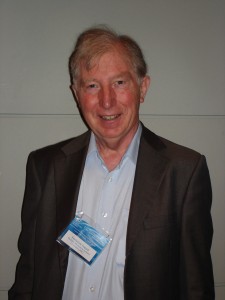
Fred Friend (source: Photo taken by Helen Szeto)
Session Overview:
Friend is here today to discuss the future of scholarly journal publishing with the movement towards the Open Access model. He begins the session by letting the audience know that the publishers in the UK are saying Open Access will destroy scholarly publishing. He continues by listing the assumptions that the publishers have. Some publishers see Open Access as a threat, while others see opportunities in the new model. Many publishers want the change in model to support rather than weaken journal publication. Publishers put the emphasis on the quality of the journal, while researchers put the emphasis on the article. They want to see public money to help increase publication. Friend asks the questions, “What kind of business models can be made viable in the future? Which models will enable high and effective use of published research?” There are large areas of agree and disagreement.
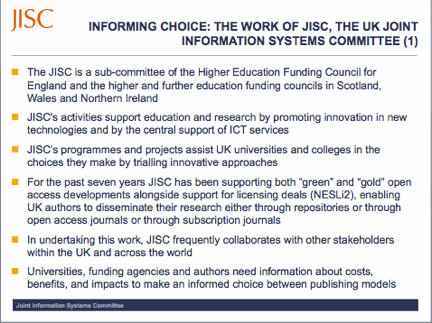
(Source: slide courtesy of Fred Friend)
This is where the Joint Information Systems Committee (JISC) comes into the conversation. It is a national committee in the UK that provides universities and researchers with information that they need in order to make the right choice. JISC is a strong supporter of open access and want to help maintain the existing model. They want to help promote innovation especially in helping universities decide which are the best innovative approaches. JISC supports both “green” and “gold” open access development alongside support for licensing deals. They want to collaborate with other stakeholders of scholarly journal publishing within the UK and world. Friend is here today to see JISC have more collaboration with the Public Knowledge Project.
The one key factor about providing information is the choice about cost and impact factor. JISC commissioned a report on the economic implications of alternative scholarly models. It also looked at how it would help the UK economy. Findings from the report showed that the UK benefited from moving towards either a self-archiving model or the gold Open Access model. It can get very fast returns by moving top open access (either green or gold). The Netherlands and Denmark have made similar reports. JISC also examines how much it will cost for institutions to switch models. They are trying to work with publishers on offering authors a choice between copyright and licensing.
Many policy statements in Europe have supported Open Access. Collectively, the European Union committed to an Open Access policy research funded through FP7. Local European institutions are considering how to manage these Open Access changes. There is stronger interest in gold Open Access in Europe than in the United States. Globally, countries with newer growth economies and less established publishers do not appear to be more advanced in Open Access developments than ones with established economies.
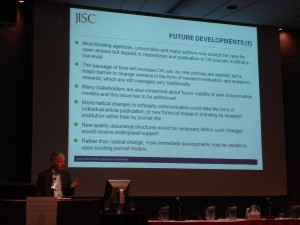
Fred Friend Presentation (Source: Photo taken by Helen Szeto)

(Source: slide courtesy of Fred Friend)
In future developments, Friend believes that there has to be a lot more in advocacy. Many researchers are concerned that their favourite journals will disappear. Fred says that academic journals will not collapse because of their importance to the research community. He believes their survival will come through changes in the repository. The academic community will take more control over the research dissemination process while publishers will act as service providers. Changes will happen, there will be variations and hybrids of new and old models. There will not be one model that will be able to dominate such as the subscription model has.
Analysis:
Friend recognizes that changes will need to be made to the subscription model in order for scholarly publishing to remain. His presentation provides a positive outlook for publishers in a world with Open Access. Both models can survive together, but changes will need to be made by both. The key word in the presentation is “change.” Things cannot stay the same; changes will have to be made to the traditional scholarly publishing model. Friend encourages everyone to go out and advocate for these changes. He believes that is the way to change the traditional model.
Session Questions and Answers:
1) One audience member said, “There are some green Open Access advocates who are very vocal about researchers …giving money to publishers when they can do it for less themselves. What is the cost of building institution repositories?
Reply: “Green Open Access is the best value for money of the 3 models, which is evident at the national level in the UK, Netherlands, and Denmark.” Friend doesn’t believe it will be the sole model used.
2) How do you get over the problem of having researchers demand certain journals?
Reply: Friend’s suggestion is to cancel subscription and buy gold Open Access journals.
3) Addressing the awareness of difference economies.
Reply: Friend says that charges to each model are based on their cost in the current system. He thinks that the costs will settle down over time. There will still be variations in models because there are different costs involved.
4) Friend comments on the voluntary labour in the publishing models. Voluntary labour is not free because mostly the institutions subsidize it. Problems occur with certain inefficiencies such as people not skilled in what they are doing. People are spending time doing something that someone else can be doing better.
5) What makes you think that the cost will be better controlled in the new models?
Reply: Friend believes that the academic community will control costs.
Related Links:
- Berlin 6 Open Access Conference: Frederick Friend
- Description of JISC’s scholarly communications work
- EFFECTIVE SCHOLARLY COMMUNICATION: JISC working for UK teaching and research presentation
- The European Commission’s open access policy
- Funding Policies and Research Access Round Table
- Google Scholar: Potentially Good for Users of Academic Information (2006)
- Open access advantages, opportunities, support: JISC and the UK parliamentary enquiry into scientific publications by F. Friend
- Negotiating Prices and Licenses for Networked Electronic Information by F. Friend
- Recommendations on paying gold OA publication charges in the UK are included in a working party report
July 10, 2009 Comments Off on Towards A New Future for Journal-Article Publishing: The Session Blog


